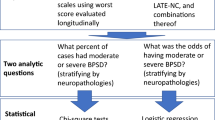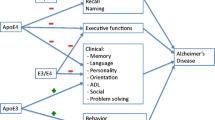Abstract
Background
Behavioral and psychological symptoms are widely accepted as accelerator factors in progression to dementia. Although alexithymia is closely related to normal aging process and poor neurocognitive performance, alexithymia has not been included in these symptoms yet.
Aims
Here, we aimed to investigate alexithymia features in people with prominent clinical memory complaints.
Methods
The participants (n = 82) were classified into three groups as: subjective cognitive decline (n = 30), mild cognitive impairment (n = 27), and mild Alzheimer’s disease (n = 25) after Mini-Mental State Examination, Clinical Dementia Rating Scale, neuropsychological test battery, Geriatric Depression Scale, and Hachinski Ischemic Scale. All participants were assessed with 20-item Toronto Alexithymia Scale.
Results
The patients with mild Alzheimer’s disease and mild cognitive impairment have significantly greater alexithymia features than individuals with subjective cognitive decline in Toronto Alexithymia Scale (p < 0.05 for all). The alexithymia features in patients with mild Alzheimer’s disease and mild cognitive impairment did not significantly differ (p > 0.05, for all).
Discussion
People who have objective cognitive decline seem to have more alexithymia features than people with subjective cognitive decline. Moreover, alexithymia features seem to be similar in people mild Alzheimer’s disease and in mild cognitive impairment.
Conclusion
Alexithymia might be an important searching domain of behavioral–psychological symptoms in people with cognitive problems beyond aging.
Similar content being viewed by others
References
Mega MS, Cummings JL, Fiorello T et al. (1996) The spectrum of behavioral changes in Alzheimer’s disease. Neurology 46:130–135
Apostolova LG, Cummings JL (2008) Neuropsychiatric manifestations in mild cognitive impairment: a systematic review of the literature. Dement Geriatr Cogn Disord 25:115–126
Peters ME, Schwartz S, Han D et al. (2015) Neuropsychiatric symptoms as predictors of progression to severe Alzheimer’s dementia and death: the cache county dementia progression study. Am J Psychiatr 172:460–465
Rubio MM, Antonietti JP, Donati A et al. (2013) Personality traits and behavioral and psychological symptoms in patients with mild cognitive impairment. Dement Geriatr Cogn Disord 35:87–97
Spalletta G, Caltagirone C, Padovani A et al. (2014) Cognitive and affective changes in mild to moderate Alzheimer’s disease patients undergoing switch of cholinesterase inhibitors: a 6 month observational study. PLoS One 19(9):e89216
Robert PH, Verhey FRJ, Byrne EJ et al. (2005) Grouping for behavioral and psychological symptoms in dementia: clinical and biological aspects. Consensus paper of the European Alzheimer disease consortium. Eur Psychiatr 20:490–496
Watters CA, Taylor GJ, Quilty LC et al. (2016) An examination of the topology and measurement of the alexithymia construct using network analysis. J Per Ass 98(6):649–659
Lane RD, Weihs KL, Herring A et al. (2015) Affective agnosia: Expansion of the alexithymia construct and a new opportunity to integrate and extend Freud’s legacy. Neurosci Biobehav Rev 55:594–611
Onor ML, Trevisiol M, Spano M et al. (2010) Alexithymia and aging: a neuropsychological perspective. J Nerv Ment Dis 198:891–895
Pendlebury ST, Mariz J, Bull L et al. (2012) MoCA, ACE-R, and MMSE versus the National Institute of Neurological Disorders and stroke-Canadian stroke network vascular cognitive impairment harmonization standards neuropsychological battery after TIA and stroke. Stroke 43:464–469
Yates JA, Clare L, Woods RT et al. (2015) Subjective memory complaints, mood and MCI: a follow-up study. Aging Ment Health 2:1–9
Bagby RM, Taylor GJ, Parker JD et al. (1990) Cross-validation of the factor structure of the Toronto Alexithymia Scale. J Psychosom Res 34:47–51
Bagby RM, Parker JD, Taylor GJ (1994) The twenty-item Toronto alexithymia scale—I. Item selection and cross-validation of the factor structure. J Psychosom Res 38:23–32
Güleç H, Köse S, Güleç MY et al. (2009) Reliability and factorial validity of the Turkish version of the 20-item Toronto alexithymia scale (TAS-20). Bull Clin Psychopharmacol 19:214–220
Güngen C, Ertan T, Eker E et al. (2002) The Reliability and validity of standardized mini-mental state examination in mild dementia for Turkish population. Turk J Psychiatr 13:273–281
Folstein MF, Folstein SE, McHugh PR (1975) ‘‘Mini-mental state’’. A practical method for grading the cognitive state of patients for the clinician. J Psychiatr Res 12:189–198
Burke WJ, Miller JP, Rubin EH et al. (1988) Reliability of the Washington University Clinical Dementia Rating. Arch Neurol 45:31–32
Morris JC, Ernesto C, Schafer K et al. (1997) Clinical dementia rating training and reliability in multicenter studies: the Alzheimer’s disease Cooperative Study experience. Neurology 48:1508–1510
Ertan T, Bugay G, Eker E (2004) The Reliability and validity of Short Form of Geriatric Depression Scale in Turkish Elderly Population. Poster in 5. National Geropsychiatry Symposium, İstanbul Turkey (in Turkish)
Yesavage JA, Brink TL, Rose TL et al. (1982) Development and validation of a geriatric depression screening scale: a preliminary report. J Psychiatr Res 17:37–49
Sheikh J, Yesavage J (1986) Geriatric depression scale (GDS); recent evidence and development of a shorter version. In: Brink T (ed) Clinical gerontology: a guide to assessment. New York, Hawthorne Press pp. 165–173
Hachinski VC, Iliff LD, Zilhka E (1975) Cerebral blood flow in dementia. Arch Neurol 32:632–637
O’Neill D, Gerrard J, Surmon D et al. (1995) Variability in scoring the Hachinski Ischaemic score. Age Ageing 24:242–246
Karakas S (2004) Handbook of Bilnot Battery (in Turkish), Ankara
Wechsler D (1987) Wechsler memory scale—revised manual, psychological corporation, San Antonio, TX
Rey A (1964) L’examen Clinique en Psychologie. Presses Universitaires de France, Paris
Golden CJ (1978) Stroop Colour and Word Test. Stoelting Publishing House, Chicago
Sunderland T, Hill JL, Mellow AM et al. (1989) Clock drawing in Alzheimer’s disease. A novel measure of dementia severity. J Am Geriatr Soc 37:725–729
Isaacs B, Akhtar AJ (1972) The SET test: a rapid test of mental function in older people. Age. Aging 1:222–226
Waller E, Scheidt CE (2004) Somatoform disorders as disorders of affect regulation: a study comparing the TAS-20 with non-self-report measures of alexithymia. J Psychosom Res 57:239–247
Taylor GJ, Parker JD, Bagby RM et al. (1996) Relationships between alexithymia and psychological characteristics associated with eating disorders. J Psychosom Res 41:561–568
Portincasa P, Moschetta A, Baldassarre G et al. (2003) Pan-enteric dysmotility, impaired quality of life and alexithymia in a large group of patients meeting ROME II criteria for irritable bowel syndrome. World J Gastroenterol 9:2293–2299
Porcelli P, Zaka S, Leoci C et al. (1995) Alexithymia in inflammatory bowel disease. A case-control study. Psychother Psychosom 64:49–53
Jula A, Salminen JK, Saarijarvi S (1999) Alexithymia: a facet of essential hypertension. Hypertension 33:1057–1061
Gundel H, Lopez-Sala A, Ceballos-Baumann AO et al. (2004) Alexithymia correlates with the size of the right anterior cingulate. Psychosom Med 66:132–140
Paradiso S, Vaidya JG, McCormick LM et al. (2008) Aging and alexithymia association with reduced right rostral cingulate volume. Am J Ger Psychiatr 16:760–769
Tabibnia G, Zaidel E (2005) Alexithymia, interhemispheric transfer, and right hemispheric specialization: A critical review. Psychother Psychosom 74:81–92
Wingbermühle E, Theunissen H, Verhoeven WM et al. (2012) The neurocognition of alexithymia: evidence from neuropsychological and neuroimaging studies. Acta Neuropsychiatrica 24:67–80
Charles ST, Carstensen LL (2008) Unpleasant situations elicit different emotional responses in younger and older adults. Psychol Aging 23:495–504
Pasini A, Delle Chiaie R, Seripa S et al. (1992) Alexithymia as related to sex, age, and educational level: results of the Toronto Alexithymia Scale in 417 normal subjects. Compr Psychiatr 33:42–46
Santorelli GD, Ready RE (2015) Alexithymia and executive function in younger and older adults. Clin Neuropsychol 29:938–955
Lamberty GJ, Holt CS (1995) Evidence for a verbal deficit in alexithymia. J Neuropsychiatry. Clin Neurosci 7:320–324
Mammarella N, Fairfield B (2014) Emotional working memory and Alzheimer’s disease. Int J Alzheimers Dis 2014:207698
Author information
Authors and Affiliations
Corresponding author
Ethics declarations
Conflict of interest
The authors declare that there is no conflict of interest regarding the publication of this paper.
Ethical approval
All procedures performed in studies involving human participants were in accordance with the ethical standards of the Ethics Committee of Cerrahpasa Medical Faculty and in accordance with the 2002 Helsinki declaration and its later amendments or comparable ethical standards.
Statement of human and animal rights
The study is performed with in accordance to the Ethical Guideline for Human Studies of World Medical Association Declaration of Helsinki 2008.
Informed consent
Written informed consent was obtained from all participants.
Rights and permissions
About this article
Cite this article
Yuruyen, M., Akcan, F.E., Batun, G.C. et al. Alexithymia in people with subjective cognitive decline, mild cognitive impairment, and mild Alzheimer’s disease. Aging Clin Exp Res 29, 1105–1111 (2017). https://doi.org/10.1007/s40520-017-0725-8
Received:
Accepted:
Published:
Issue Date:
DOI: https://doi.org/10.1007/s40520-017-0725-8




